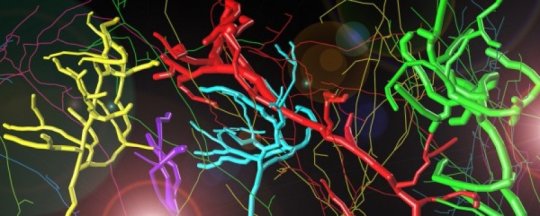
Supercomputing resources at the Department of Energy's Oak Ridge National Laboratory will support a new initiative designed to advance how scientists digitally reconstruct and analyze individual neurons in the human brain. Led by the Allen Institute for Brain Science, the BigNeuron project aims to create a common platform for analyzing the three-dimensional structure of neurons.
"Neuronal reconstruction is a huge challenge for this field," said ORNL's Arvind Ramanathan. "Unless you understand how these different nerve endings are connected to each other, you're not going to make any sense of how the brain is functioning."
Digital algorithms could help automate the process, but researchers worldwide use different approaches to collect images, manage data and create their models. The BigNeuron collaborators hope to standardize the process and identify which algorithms are best suited for different neuron types, which would accelerate scientists' attempts to map every neuron in the brain. The human brain contains nearly 100 billion neurons.
ORNL's Titan, the second most powerful supercomputer in the world, will allow scientists to gauge which algorithms are most effective at reconstruction and tune the codes to take advantage of high-performance computers.
"By bench-testing, we'll get an idea of which ones tend to perform better than others," Ramanathan said. "If Titan were to help even one of these algorithms to run faster or better, then I think that would be a huge win."
In a series of BigNeuron workshops, participants will contribute neuron reconstruction algorithms and datasets to a common software platform. ORNL will provide a supporting framework through its computing and data management resources, including the lab's Health Data Sciences Institute, a multidisciplinary initiative designed to examine these kinds of complex, heterogeneous datasets.
"Neuroscience imaging represents a unique type of dataset that typically requires supercomputing," Ramanathan said. "The computers will be used for what they do best, which is massive amounts of computation in a short amount of time. Plus, hosting these very large and complex datasets is at the heart of what we do every day."
Ramanthan also hopes ORNL's involvement in the initiative will further integrate the high-performance computing and brain science communities. Although supercomputing is used for image reconstruction in applications such as satellite imagery, neuroscience presents unique challenges.
"Brain science is very specialized; you can't take an existing algorithm and make it to work with brain data," he said. "We want to show that Titan can handle all these types of datasets."
Scientists anticipate that mapping the neuronal connections in an entire brain could provide a wealth of insights in medicine, but Ramanathan notes that BigNeuron is only an initial step in that direction. The project aims to lay the groundwork to enable these future studies.
"The biological implications are huge," said Ramanathan. "If it works on a healthy human brain, then you can do these analyses on a diseased human brain, on patients with Alzheimer's or Parkinson's for instance, to try to understand how the wiring is different. That could lead to many different avenues and hopefully drive the future of medicine.
"First we need to build the basics, the tools of trade. Because these systems are so complex and so important, the community is trying to do this as accurately and systematically as possible," he said.

 Previous page
Previous page Back to top
Back to top







